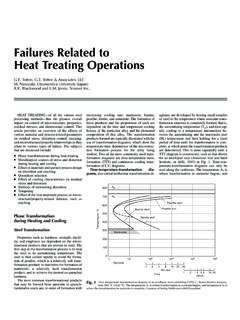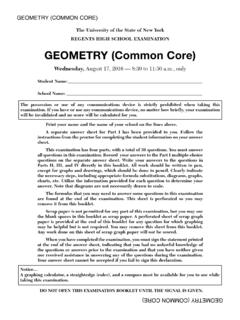Transcription of Ultra High Temperature Ceramics: Densification, Properties ...
1 AL03-08 1 Issue 3 - November 2011 - Ultra high Temperature Ceramics: Densification, Properties and Thermal StabilityHigh Temperature MaterialsUltra high Temperature Ceramics: Densification, Properties and Thermal Justin, A. Jankowiak(Onera)E-mail: flights, re-entry vehicles, and propulsion applications all require new materials that can perform in oxidizing or corrosive atmospheres at temperatures in excess of 2000 C and sometimes over the course of a long working life. Ultra high Temperature Ceramics (UHTCs) are good candidates to fulfill these requirements. Within this family, the ZrB2 and HfB2 based composites are the most attractive. The oxidation resistance of diboride-based compounds is better than that of SiC-based ceramics thanks to the formation of multi-oxide scales composed of a refractory oxide (skeleton) and a glass component.
2 Onera is actively involved in several programs to develop such materials for both hypersonic civilian flights and for propulsion systems. In this paper, we present the ZrB2-SiC, ZrB2-SiC-TaSi2 and HfB2-SiC-TaSi2 composites developed in the Onera laboratories for leading edges or air intakes of future hypersonic civilian aircrafts flying up to Mach 6 (T~1100 C-1500 C) with comparisons with the state of the art. Then we discuss new perspectives for higher Temperature applications (T>2000 C).IntroductionUltra high Temperature Ceramics (UHTCs) are good choices for several extreme applications: thermal protection materials on hypersonic aerospace vehicles or re-usable atmospheric re-entry vehicles, specific components for propulsion, furnace elements, refractory crucibles, etc. This family of ceramic compounds is made of borides, carbides and nitrides such as ZrB2, HfB2, ZrC, HfC, TaC, HfN which are characterized by high melting points (table 1), high hardness, chemical inertness and relatively good resistance to oxidation in severe , this family of ceramic materials was first investigated between the 1950s and 1970s by Russian and laboratories [1][2], but recent studies to develop hypersonic flight vehicles in particular have led to a resurgence of interest.
3 For hypersonic vehicles with sharp aerosurfaces (engine cowl inlets, wing leading edges and nosecaps), there are foreseeable needs for materials that can withstand temperatures of 2000 to 2400 C, operate in air and be re-usable [3]. At present, the structural materials for use in high - Temperature oxidizing environments are limited to SiC and Si3N4 based materials, oxide ceramics and C/C composites with thermal protection. Silicon-based ceramics and protected C/C composites exhibit good oxidation resistance, but only up to ~1600 C, and their thermal cycling lifetimes are modest. The development of structural materials for use in oxidizing and rapid heating environments at temperatures above 1600 C is therefore of great importance for structureDensity (g/cm3)Melting temp rature ( C) 2545 Table 1 Properties of some UHTCs AL03-08 2 Issue 3 - November 2011 - Ultra high Temperature Ceramics: Densification, Properties and Thermal StabilitySince the 1950s, studies have revealed that diborides of the group IVb were the most resistant to oxidation and among these compounds, HfB2 was the best, followed by ZrB2.
4 However, the use of single-phase materials was not sufficient for high - Temperature structural applications. Thus, many additives such as Nb, V, C, disilicides and SiC were evaluated to improve the resistance to oxidation. Of these additives, SiC seemed to be particularly valuable and 20 vol% was judged optimal for hypersonic vehicles by the US Air Force. At present, many groups in the , Japan, China, India and in Europe (especially in Italy) are studying UHTC systems to improve resistance to oxidation [4][5][6][7]. Moreover, in comparison with carbides and nitrides, the diborides have also higher thermal conductivity, which gives them good thermal shock resistance and makes them ideal for many high - Temperature thermal applications. For a leading edge for example, a high thermal conductivity reduces thermal stress within the material by lowering the magnitude of the thermal gradient inside the part.
5 Furthermore, it allows energy to be conducted away from the tip of the piece and re-radiated out of the surfaces of the component with lower heat fluxes [8]. Diboride-based UHTCs also exhibit high electrical conductivity (table 2), which is appreciable for manufacturing complex shape components for example (by using Electrical Discharge Machining). Over the past five years, Onera has carried out several activities on UHTC materials. This paper is an outline of the work which has been done on these materials in the Composite Materials and Structures Department. First, we describe the ZrB2-SiC, ZrB2-SiC-TaSi2 and HfB2-SiC-TaSi2 composites developed for leading edges or air intakes of the ATLLAS vehicle (future hypersonic civil aircraft flying up to Mach 6) in comparison with the state of the art.
6 In conclusion, new perspectives and compositions for higher Temperature applications (T>2000 C) are system space group prototype structureHexagonalP6/mmm AlB2 HexagonalP6/mmm AlB2a ( ) ( ) (g/cm3) temp rature ( C)32453380 Young's modulus (GPa)489480 Hardness (GPa)2328 Coefficient of Thermal Expansion ( C-1) x x 10-6 Heat capacity at 25 C ( C-1) conductivity ( C-1)60104 Electrical conductivity (S/m) x x 106 Table 2 Summary of some Properties of ZrB2 and HfB2 [9]Future hypersonic aircraft materialsContextIn 2006, the European Community launched a 3-year project called ATLLAS (Aerodynamic and Thermal Load Interactions with Lightweight Advanced Materials for high Speed Flight) to initiate research on high - Temperature resistant materials for sustained hypersonic flight (up to Mach 6). The project [10], led by ESA-ESTEC, consists of a consortium of 13 partners from industry, research institutions and universities (ASTRIUM, EADS-IW, MBDA, ALTA, GDL, DLR, FOI, ONERA, SOTON, ITLR, TUM, UPMC and ESA-ESTEC).
7 Within this program, ONERA DMSC has the objective of investigating and manufacturing materials to allow for the designing of sharp leading edges or air intakes for the ATLLAS reference vehicle [11]. For hypersonic vehicles, performance improvement (lift-to-drag ratio in particular) requires slender aerodynamic shapes with sharp leading edges. However, the thinner the leading edge radius, the higher the Temperature . Successful designs for hypersonic aircraft therefore require the development of new materials with higher Temperature first part of the study focused on the choice of suitable compositions to define UHTC solutions for slender aerodynamic shapes. The selection was based on four different criteria: the requirements for these applications (see box 1) taking into account the flight parameters of the ATLLAS vehicle (speed, altitude, etc.)
8 And the shape of the piece (sweep back angle, tip radius, etc.), the processing methods available at Onera, the bibliographical results on similar applications and the thermodynamic stability predictions of the selected compositions. According to these criteria, a preliminary selection of three compositions that are feasible by hot pressing [12][13] (expected sintering Temperature between 1600 and 2000 C), has been done: ZrB2 (60 vol%) + SiC (20 vol%) + TaSi2 (20 vol%) HfB2 (60 vol%) + SiC (20 vol%) + TaSi2 (20 vol%) ZrB2 (80 vol%) + SiC (20 vol%)In these compositions, silicon carbide additives are used firstly to enhance resistance to oxidation, secondly to promote densification by restricting the growth of diboride grains, and lastly to lower their sintering Temperature [14].
9 According to several studies, additions of 20 vol% were judged optimal for our application. For tantalum disilicide additives, the objectives are to increase oxidation resistance and to reduce the sintering Temperature of the powder blends [14][15] (the melting Temperature of the TaSi2 is only 2400 C). The addition of Ta to the system reduces the concentration of oxygen vacancies and decreases oxygen transport through the growing oxide scale and thus lowers the oxidation rate. Furthermore, Ta additions increase the oxide scale adhesion by phase stabilization. As for the last composition, it is a classical ZrB2/SiC material. It has been studied in order to provide reference points for comparison with the first two compositions and the results from the procedureTo obtain the three selected compositions, commercially available ZrB2, HfB2, SiC and TaSi2 powders (table 3) were used as precursors.
10 The preparation of the blends involved three successive stages. First, to reduce particle size distribution and promote intimate mixing, the mixtures were ball milled in cyclohexane for several hours using Si3N4 milling media in a high -density polyethylene tank. Rotary evaporation was then used to extract the solvent and minimize segregation during drying. Lastly, the powder blends were sieved to avoid agglomeration. During the study, various improvements were made to this cycle in order to obtain the purest mixtures: a significant decrease of the total duration of attrition, the use of YTZ (ZrO2) grinding media and optimization of the order of introduction of the constituents. AL03-08 3 Issue 3 - November 2011 - Ultra high Temperature Ceramics: Densification, Properties and Thermal StabilityStarting powderParticle size ( m)Grade / supplierPurity (%) / / / Starck> / 3 Size, grade and purity of starting powdersThe second phase of the process involved sintering the previous powder blends by hot pressing.




